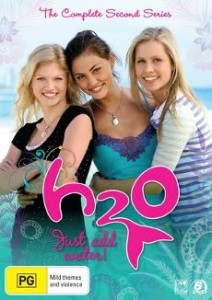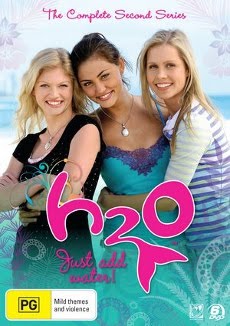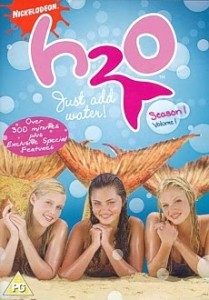
H2O: Just Add Water is a mermaid series for teens and tweens, which ran for three seasons between 2006 and 2010. Part 1 (over here) considers the series in the context of other mermaid media and reviews season one. Part 2 (this section) reviews season two. Part 3 (over there) deals with season three, wider themes/issues and the upcoming spinoff series, Secret of Mako Island.
(Due to covering three seasons, there are some inevitable spoilers and a few stand-alone episodes are discussed in more detail. However, I’ve avoided discussing the season finales and there will still be a lot of surprises.)
Review: Season Two
Plot Overview
The girls (Cleo, Rikki and Emma) have settled into their lives as mermaids. This is thrown off when they gain additional powers (over weather elements – wind for Cleo, lightning for Rikki and snow for Emma), but they soon learn to handle them.
Their personal lives are another matter. Cleo is dealing with her parent’s divorce and confused about her relationship with Lewis. Things get complicated for Rikki when her ex-boyfriend reappears. Emma has continuing issues hiding things from her family, and there’s friction when she meets riding instructor Ash.
Whilst this is going on, a new girl at school – Charlotte – takes a shine to Lewis. Cleo takes an instant dislike to Charlotte as she still has feelings for Lewis, and thus a love triangle is born.
The season is slow to get going, but after a lot of floundering, we find out some more about the 1950s mermaids and the final conflict becomes apparent.
Antagonists
Charlotte is not instantly obvious as an antagonist. She’s intelligent, artistic and is initially friendly. But there are early hints that she’s self-centred and manipulative. When the focus starts to slip away from her, a smile and the right comment switches things around so she gets her way. When she organises a party for Lewis, it’s clearly what she wants… his preferences don’t factor into it.
That said, being a bit manipulative doesn’t make a person instantly hateable. Charlotte’s motives for her interest in Mako Island are sympathetic. It’s understandable that the girls don’t want Charlotte finding anything out, as she might expose them, but it’s also understandable why Charlotte wants to know.
One plus side is that criticisms of Charlotte are based on her behaviour and motives. Cleo drew away from the appearance slams used in the first season, and no one else jumps on that wagon either. Charlotte’s heavier than the other girls, yet there’s a lack of classic fat stereotypes – she doesn’t overeat, she’s not unfit and she doesn’t hate herself. Her issues with the girls are not connected to her looks*.
There weren’t as many minor antagonists this time around. Nate, Zane’s best friend, was the main one. He took a similar role to Miriam, as the shallow antagonist who causes minor issues here and there. There’s never anything deeper there.
Allies
Lewis continues to be the biggest ally for the girls, though this is tested due to the love triangle (Charlotte doesn’t like Lewis hanging out with the girls). In the first season, Lewis had his moments of being a little over-protective and clingy. He goes all out in the early part of the second season… and get slapped for it. This behaviour initially causes Cleo to dump him. Later, when he tries to overrule a decision the girls have made, they go for it anyway and prove him wrong. Afterwards, he admits they were right.
After endless stories where overprotectiveness is shown as desirable, and girls who go against the wishes of men/boys always have it blow up in their face (should’ve listened to the menfolk!), it’s nice to see the reverse. Lewis does a whole bunch of maturing towards realising people in relationships need to be equals and don’t need to be in each other’s space 24/7.
A new edition is Max, an elderly man who was friends with the ’50s mermaids (in a similar role to Lewis).
Class Issues
Rikki’s home is shown for the first time. It wasn’t a surprise that she lived in the trailer park, as there’d been hints, but this time it was on-screen.
It’s common for poor people to be shown as universally bad, outside of the poor young protagonist who is trying to rise above it. Their parents will be abusive, greedy and a waste of space. H2O didn’t go down that route, which was heartening to see. Rikki’s dad obviously cares about his daughter and they have a close relationship. He’s not poor because he’s lazy and evil. He’s poor because his job doesn’t pay well and there’s nothing he can do about it (which is the reality for most poor people).
Rikki is hesitant to bring her friends home, due to what they might think. Some of Rikki’s differences in attitude to money were clear in this season too. She doesn’t like people giving her money and gifts, seeing it as charity**. This is in comparison to rich boy Zane, who throws money and gifts around, because it’s never been something he had to worry about.
Irresistible – Episode Comments
One episode introduces a scent which mesmerises the girls. They’ll do anything the wearer says, and don’t remember any of it once out of the scent’s range. Though presented in a tween-friendly mermaid magic way, it’s a clear analogue to using alcohol or drugs to control girls. Though some of the scenarios are played for comedy, the boys take the threat seriously and the girls are clearly upset afterwards. They don’t blame themselves, which sounds like a small thing, but too often themes like this end up with the girls thinking it was their fault.
I had mixed feelings on this one. It’s a little twee for the serious nature of the subject, but it’s also not a bad first introduction to it either. The blame is placed where it’s due and the overall conclusion is it isn’t acceptable.
Overall Views
This season was weaker than the first. There were some fun stand-alone stories (sea fungus!), it was good to see Rikki’s home life and I liked Max. But the main storyline took too long to get going. It floundered around in love triangle land and some episodes hardly had any mermaiding. Once the season finale got going, it was a lot stronger, but it was a bit of a slog getting there at times.
Originally, two seasons were planned, so this would have been the end. The two main storylines are ended in a satisfying way. The girls are left at a point where things are stable. The gaps in the ’50s story are filled in by Max. Of course, it didn’t end there, as a third season was produced, but the writers had to polish things off as though there wasn’t going to be another season.
–
* On the other hand, fan comments can be a scary, scary place. There are a lot of criticisms of Charlotte’s weight, saying she’s fat and ugly, and they can’t imagine why anyone would want to date her. This ties in to my comments on season one, about using appearance criticisms against female antagonists. It happens so often, people internalise it as normal behaviour. The people who criticise a fictional character based on appearance rather than behaviour are going to be treating real people in exactly the same way.
One series can’t change the tide, but it doesn’t mean they have to add to it.
** I’ve had problems trying to explain this in the science fiction and fantasy writing world. It’s a lot harder to apply for a grant for conventions and courses when you’ve been raised with less money. Money is a big deal. Not being able to support yourself is a big deal. So accepting money, especially for something that isn’t life-or-death, is a lot harder than it might be for someone where money has never been an issue (and therefore isn’t viewed as being as important). This tends to get dismissed as ‘silly’, when it’s an issue that does need to be considered, because the people who most need grants can be the least likely to apply. Telling them they’re stupid and failing to understand why doesn’t help.



 Series: Above World, #1
Series: Above World, #1